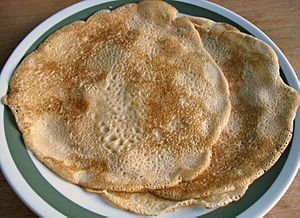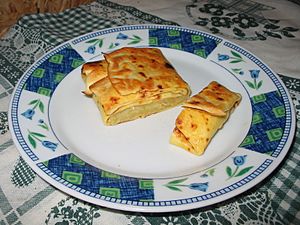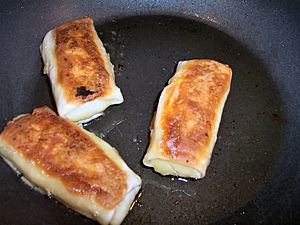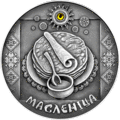Blini facts for kids
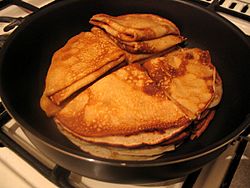
Blini
|
|
| Alternative names | Blin, bliny, blintchik, blynchyky |
|---|---|
| Type | Pancake |
| Place of origin | Russia |
| Main ingredients | Wheat, eggs, milk |
A blini (sometimes spelled bliny) (Russian: блины pl., diminutive: блинчики, blinchiki, dialectal, diminutive: млинчики, mlynchiki) or, sometimes, blin (more accurate as a single form of the noun), is a Russian and more broadly Eastern European pancake traditionally made from wheat or (more rarely) buckwheat flour and served with smetana, tvorog, butter, caviar and other garnishes. Blini are among the most popular and most-eaten dishes in Russia.
In the West, the term blini traditionally refers to small (2-4 inches in diameter) savory pancakes made with leavened batter. In modern Russian, the term most often refers to pan-sized leavened thin pancakes, although smaller leavened pancakes are also called blini and were much more common historically.
Some English dictionaries record usage of the forms blin as singular and blini or bliny as plural, which correspond to the originally Russian forms, but other dictionaries consider this usage so rare in English that they do not mention blin at all and only record the widespread modern regular usage of blini for the singular and blinis for the plural. Some cookbooks and restaurants use blin and blintchick as in Russian to refer to crêpes.
Blintzes are an offshoot (an evolved or variant form) of blini. They are thin pancakes usually made of wheat flour (not buckwheat), folded to form a casing (as for cheese or fruit) and then sautéed or baked.
Etymology
The Old Slavic term for the Russian pancakes was probably mlinŭ, which transformed in Old Russian into mlinъ, blinъ,(млинъ/блинъ), (cf. mlynets’ (млинець), Ukrainian for blin). While the Russian word блины́ bliný (plural of блин blin) refers in modern Russian also to the introduced foreign pancakes in general, meanwhile the term Ру́сские блины́ Rússkiye bliný (Russian pancakes) is often emphasized in Russia for differentiation.
History
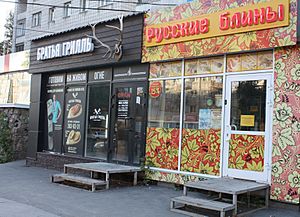
Blini were considered by early East Slavic people in pre-Christian times to be a symbol of the sun, due to their round form. They were traditionally prepared at the end of winter to honor the rebirth of the new sun (Butter Week, or Maslenitsa, also called "pancake week"). The tradition of a dairy festival at that time of year was adopted by the Orthodox church as a way of using up dairy products before the start of Great Lent. This tradition is observed by Western Christians as Pancake Day. Drochena, a kind of blini, was also served at wakes to commemorate the recently deceased.
Traditional Russian blini are made with yeasted batter, which is left to rise and then diluted with milk, soured milk, cold or boiling water. When diluted with boiling water, they are referred to as zavarniye bliny. A lighter and thinner form made from unyeasted batter (usually made of flour, eggs, milk or soured milk, kefir, ryazhenka, varenets), is also common in Russia. Traditionally, blini are baked in a Russian oven. The process of preparing blini is still referred to as baking in Russian, even though they are nowadays pan-fried, like pancakes. All kinds of flour may be used, from wheat and buckwheat to oatmeal and millet, although wheat is currently the most popular.
Jewish version
A somewhat similar Jewish dish exists, and is a very popular traditional Ashkenazi Jewish dish called blintz. Blintzes were popularized in the United States by Eastern European Jewish immigrants. Blintzes are a very important part of Jewish cuisine in some regions. They are traditionally served for several holidays in Judaism, such as Shavuot. Blintzes stuffed with a cheese filling and then fried in oil are served on holidays such as Hanukkah (as oil played a pivotal role in the miracle of the Hanukkah story) and Shavuot (when dairy dishes are traditionally served within the Ashkenazi minhag). Blini and blinchiki are ordinarily stuffed before being fried a second time, wrapped around stuffing and eaten without refrying, or simply folded and eaten with a dip. Fillings include chocolate, mushrooms, meat, rice, mashed potatoes and cheese.
Ukraine
Blini, or as they are known in Ukrainian, mlyntsi, are a highly popular dish around Ukraine, the simplicity of making the thin pancakes as well as the basic ingredients yet highly favourable taste have led to the popularity of the dish. Mlyntsi have been eaten in Ukraine since pre-Christian times. Mlyntsi tend to be served in Ukraine with sour cream (Ukrainian: smetana) as well as with caviar; they can also be served as a sweet dish by serving them alongside a fruit preserve or a sweet cream. The thin pancakes can also be stuffed with cottage cheese, chopped boiled eggs, mixed green onions, stewed cabbage, minced meat, mashed beans, mushrooms, fruit and berries and raisins. However upon being stuffed the dish acquires a new title (Ukrainian: Налисники, nalysnyky), a fundamental dish of Ukrainian cuisine that is served all around the country with a number of regional varieties, for example the Chernihiv style nalysnyky are marked by their mushroom and cabbage filling. The most popular form of nalysnyky served in Ukraine is those stuffed with cottage cheese and served with sour cream. Nalysnyky as well as mlyntsi are also served for special occasions such as Masnytsya, which may originally have been a pagan festival that celebrated the end of winter and the arrival of spring (the round yellow pancake most likely symbolising the sun), but has for a millennium been the time for using up dairy products before the beginning of Great Lent. Nalysnyky can be formed out of mlyntsi in a number of different shapes including; tubes, envelopes and even triangles. Some recipes call for the stuffed mlyntsi to be placed in an oven proof dish and cooked in an oven.
Varieties
Some ways that blini are prepared and served include the following:
- Blini made from batter containing various additions such as grated potato or apple and raisins. Such blini are quite common in Eastern Europe and are more solidly filled than the spongy pancakes usually eaten in North America.
- Blini covered with butter, sour cream, varenie or jam, honey or caviar (whitefish, salmon or traditional sturgeon).
They may be folded or rolled into a tube with sweet or salty fillings such as varenye, fruit, berry, mashed potatoes, quark, cooked ground meat, cooked chicken, salmon, chopped boiled eggs with green onions or chopped mushrooms.
- Blini made by pouring batter over chopped vegetables, meat or mushrooms put on a frying pan beforehand are called "blini s pripyokom".
- Blintzes. A filling such as varenie, fruit, potato, quark, cottage cheese or farmer cheese, cooked ground meat, cooked chicken and even chopped mushrooms, bean sprouts, cabbage and onions (for a Chinese spring roll-type blintz) is rolled or enveloped into a pre-fried blintz and then the blintz is lightly re-fried, sautéed or baked. Such blintzes are also called nalysnyky (Ukrainian: налисники). Caviar is a popular filling during Russian-style cocktail parties.
- Buckwheat blini are part of traditional Russian cuisine. They are also widespread in Ukraine, where they are sometimes known as hrechanyky (Ukrainian: гречаники), and Lithuania's Dzūkija region, the only region of the country in which buckwheat is grown, where they are called grikių blynai.
Blini are considered to be the traditional meal in Lithuanian culture on Shrove Tuesday.
-
An old woman prepares blini in a Russian oven for the religious and folk holiday Maslenitsa. Postcard of pre-revolutionary Russia (before 1917) by B. V. Zvorykin.
-
Blini served with red caviar
See also
 In Spanish: Blini para niños
In Spanish: Blini para niños



